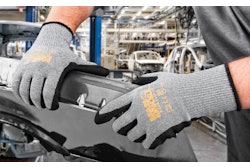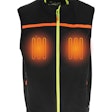
For its many benefits, some construction workers may choose to wear apparel made of polyester fabric.
According to information from Apex Mills, a technical textile supplier in New York, polyester is a synthetic fiber, chemically produced from derived compounds. Ethylene and p-xylene are extracted from petroleum to make polyester. The monomers are mixed with dimethyl terephthalate, creating the polymer polyethylene terephthalate (PET), the plastic used in soda and water bottles.
Once the PET is formed, it is extruded so it can dry and harden and is then cut up into small pellets. The PET pellets are once again melted. The molten PET is extruded through tiny holes to form thread. The cooled threads harden into polyester fibers. The fibers are twisted into polyester yarn to be knit into fabric.
Another polyester type is PCDT polyester, which is similar to PET, although the chemical structures are different, using poly poly-1, 4-cyclohexylene-dimethylene terephthalate and most often used in heavy-duty applications such as curtains or upholstery. The use of polyester is criticized by some for not being a sustainable raw material and contributing to waste. Some companies have come up with ways to make it more sustainable.
Types of Polyester
Apex notes that in addition to polyethylene terephthalate (PET), other polyester types include plant-based polyester in which the ethylene needed for polyester is derived from plants like sugar cane or bio-waste, or waste that mainly includes organic materials such as food scraps or sawdust.
According to the Netherlands company TenCate, another option is the use of recycled polyester fibers extracted from recycled plastic bottles. Using recycled polyester fibers leads to the helping to meet carbon-neutral goals by reducing the number of plastic bottles entering the landfills and a reduction in the use of petroleum used to make virgin polyester, the company notes.
The recycled polyester offers almost the same properties as virgin polyester with environmental gains as it is designed to be durable, lightweight, crease-resistant, color-fast, quick-drying, stain resistant, eco-friendly, and economical, according to TenCate.
Polyester fabric is favored for use in apparel worn by construction workers in some situations because of its many benefits.
Properties of Polyester
Polyester fabric is considered durable, has strong elasticity, and is considered abrasion-resistant. As such, it can withstand wear and tear when working around rough surfaces and equipment. The material is favored for offering breathability and comfort. It is lightweight and wrinkle-resistant.
Polyester is highly resilient to heat, light, and can withstand exposure to UV lighting. The Skin Cancer Foundation notes that shiny polyesters are highly protective because they reflect radiation. Other factors that ramp up protection include darker colors, loose fits as fibers that pull away from each other allow more UV light to pass through, and greater skin coverage.
Polyester also offers moisture-resistance, wicking away liquid droplets instead of soaking them up.
In humid and hot conditions, wearing polyester may help construction workers wearing it stay cool and dry. Polyester may be a good choice for a base layer under additional layers of clothing in cold weather in that it wicks moisture away from the body. The moisture-wicking characteristic also tends to make polyester fabric less breathable, so some clothing manufacturers will offer a blend of polyester and cotton alternative.
Apex Mills notes that inexpensive or poorly-made polyester can feel rough, especially on sensitive skin. Polyester also is designed to be easily washable, quick drying and resistant to mildew and most chemicals.
Fire Resistance
While not generally considered to be fire retardant, polyester is regarded as a fire-resistant material because of its high heat tolerance.
While synthetic fabrics such as polyester resist ignition, once they are ignited, the fabrics melt with the hot, sticky melted substances causing localized and extremely severe burns. As such, it may not be suitable for working in an environment with fire risks. Polyester can generate static electricity and while some approaches for mitigating it may include using fabric softeners, it general, polyester may not be suitable clothing for working in an environment where static discharge is a safety concern.
Jobsite regulations always dictate the type of apparel workers should wear, including the material from which it is made. Check with the safety manager to determine whether wearing apparel made from polyester is appropriate for a job task.















